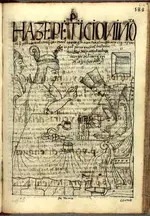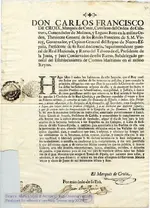Okay,
Since I see that some are chomping at the bit to get the next part started, lets open the floodgates!
I WANT TO REPEAT ONE THING HERE: Please, no Anti_Catholic Flaming! No quotes about Jesuit Assassins or the like. If you are quoting something, please reference it! If it is an opinion, PLEASE SAY SO!
About as far as I'm willing to go on the Jesuit Conspiracy Trail is the Monita Secreta Societatis Iesu. I have read enough evidence on both sides of the case (of its authenticity) that I am willing to say it is more likely than not to be authentic. If you don't know what it is, please Google it.
Previously, it has been stated that the Jesuit Precept against mining or having any knowledge (direct or indirect) was first put to paper in 1747, but I have found that to be inaccurate. Found in a random mission was a Precept from Father Provincial Francisco de Arteaga (1699-1702). This would fall right in line with the Jesuit Agreement with King Charles III to have free reign over Northern New Spain with a restriction against Mining. It reads:
No one will possess knowledge about mining either directly or indirectly; even if his intention is to have a general knowledge about everything, such knowledge would fall under this precept.
This precept was again restated in the precepts of Father Provincial Andres Javier Garcia (25 June 1747). It reads:
No one will work mines. This includes the prohibition that no one will have any knowledge about the matter of mining either directly or indirectly. The intention of the precept is to include all forms of knowledge or interpretations that could even fall within the same precept.
So, our FIRST official NO MINING Regulation was in 1699. Since this WAS an Ecclesiastical Precept, for a Jesuit Priest to mine
OR HAVE ANY KNOWLEDGE OF MINING (at least, I believe, displaying any knowledge of mining) would have been a sin! It would have meant breaking his vow of OBEDIENCE. Above all the vows a Jesuit is required to take, the Vow of Obedience is the most important. It was singularly mentioned by none other than Saint Francis Xavier when he penned his VERY FAMOUS: "Letter of Obedience" at Coimbra , Portugal on 26 March 1533. That letter became an ascetical classic, and was read MONTHLY IN ALL JESUIT HOUSES OF FORMATION. He states; "Of course, I wish you to be perfect in all spiritual gifts and adornments. But it is especially in the virtue of obedience, as you have heard from me on other occasions, that I am anxious to see you signalize yourselves." Probably the most important vow a Jesuit can take. Now, knowing how important the Vow of Obedience was (is) to a Jesuit, there can be NO WAY any Jesuit Priest would EVER break that vow, now would there? As a matter of fact, yes. It happened VERY REGULARLY. In my next post, I will show you several restatements of the precept against speaking about matters private to "Ours" (the Jesuit Order) that include statements about how that precept was being continually broken.
I'll continue with another quote from Father Charles W Polzer SJ regarding Jesuit Mining activities from his article in the Aug 1962 edition of Desert Magazine:
From archival sources, we know of only two instances in which Padres became involved in mining operations (these being in the Sierra Madre Mission Area). In both cases the men were severely reprimanded and removed.
I included the entire quote for the sake of honesty. While Father Polzer SJ admits that instances of mining occurred, he further states that both men were reprimanded and removed. While on one hand, it shows that the Order did not officially condone mining, it DOES show that some instances of it DID happen. Once again, for Father Polzer to actually admit that little tidbit is an astounding revelation (even if it is not completely honest)!
Now, lets get back to the subject of Jesuit Letter Cryptography. I put the basic precept out there to see the naysayers make fools of themselves (again). If they simply read the book by Father Charles W. Polzer SJ; "Rules and Precepts of the Jesuit Missions of Northwestern New Spain", they would find a follow-up precept to the one stated previously on the subject (I will restate it here again):
#17: Inasmuch as possible Ours will avoid writing letters to Ours complaining about the laity. If a letter has to be written, let it be so done that, even if lost or opened, the person about whom the letter was written could not understand it. The same caution is to be observed when writing the Provincial about THINGS THAT MUST BE DEALT WITH SECRETLY BECAUSE EXPERIENCE HAS SHOWN THE CONTRARY PRACTICE CREATES GRAVE INCONVENIENCES."
Now, foolish skeptics, READ WITH HORROR, as Father Alonso de Arrivillaga in 1715 states (nay, he PLEADS) not only mentions incriminating letters, but instructs the priests what to do with them. Read now,. and tremble in fear:
In the matter of writing and keeping letters many serious improprieties have been observed. Since, as we are mortals, the written word remains, letters can serve as the father of rumors and the seedbed of discord. Wherefore, I beseech you in the busom of Jesus Christ, THAT WHOEVER HAS SUCH LETTERS WILL HEREUPON BURN THEM (AS OTHERS HAVE ALREADY DONE). In the future, the Fathers should take a careful look at what they are writing because LITTERA SCRIPTA MANET and they can break charity apart in various ways which is something we should take very much to heart in our Society which is after all a society of love.
THAT WHOEVER HAS SUCH LETTERS WILL HEREUPON BURN THEM (AS OTHERS HAVE ALREADY DONE)
LITTERA SCRIPTA MANET
What does that mean my beautiful little snowflakes? NO FAIR GOOGLING! Okay, I'll tell. It means:
It is a part of a very old Latin Phrase "VOX AUDITA PERIT, LITTERA SCRIPTA MANET" translated as "The Spoken Word Perishes, The Written Word Remains"
NOW, is there anybody who doesn't understand why there are no or VERY FEW extant documents that speak of Jesuit Mining or any sort of Intrigues? ANYBODY?
No, it's very simple. We have one Ecclesiastical Precept that says "Whenever a letter has to be written about a sensitive subject, do it in code, and another that came later (this could only be because a lot of Priests were not encoding their letters, and even keeping them. This scared the living crap out of the Jesuit Leaders in Spain and Rome, so they issued another Ecclesiastical Precept that BESEECHES them to "burn any such letters (as others have already done)"
I'm done for the night. I'll let this sink iinto your heads for a bit.
Best-Mike














